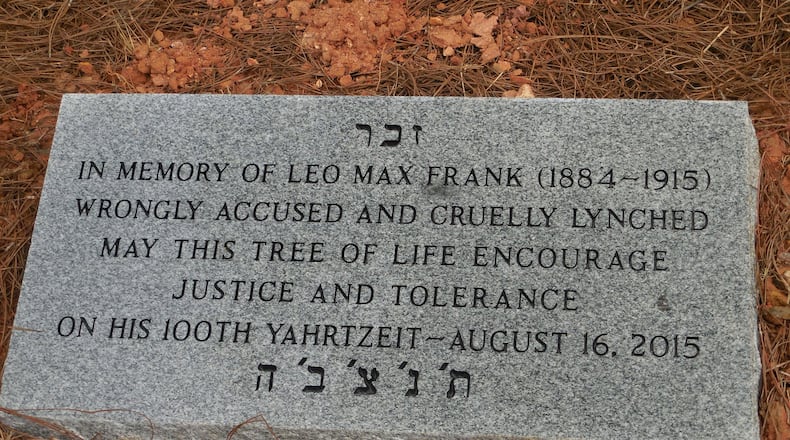In 1915, as Leo Frank’s corpse dangled above their heads, the brightest stars of Georgia’s business and political class celebrated their handiwork. So did farmers and shopkeepers and cooks. The residents of the town of Marietta were unabashedly joyful at the turn of events. They wanted mementos from it. They tore Frank’s nightshirt to shreds to make souvenirs. They picnicked proudly under the hanging tree like gratified terrorists. The “savage” New York Jew accused of killing a beautiful 13-year-old white girl was dead. They had defied Gov. John Marshall Slaton’s commutation of the death penalty in the name of social justice.
Now, any fool with a clear mind and a small bundle of facts could see model-citizen Frank was innocent of the crime. A far more likely candidate lay close at hand. What was it that clouded their minds, filled them with bias, with anger and hate, and set off a mob who knew better than the governor?
Credit: Handout
Credit: Handout
Easy question. The Atlanta newspapers murdered Leo Frank. Let’s be honest about that.
In Leo Frank’s world, newspapers were kings. You might get your news a little late out in the country, but in the city of Atlanta, developments in infamous cases hit like lightning bolts and were updated by the minute. On street corners throughout in the city, newsboys peddled as many as eight extras a day when the news was hot. Handbills of dubious provenance materialized overnight touting opinions on a sensational case like Frank’s.
The news has always been as fiercely competitive a business as anything else we’ve got. In Frank’s day, it was often cutthroat and dishonest. Bribes were taken and given to inflame or squelch news.
Rupert Murdoch has nothing on William Randolph Hearst’s The Georgian. Hearst didn’t own The Georgian in 1906 when its scurrilous articles on fictitious Black men raping white women sparked race riots in Atlanta, resulting in the deaths of at least 25 Black men and two whites, but he did nothing to improve the paper’s reputation with its coverage of Leo Frank’s trial. Tom Watson, a proud white supremacist and owner of the popular Jeffersonian, was worse. He was not content with persecuting Frank. Watson indicted the whole community of “rich Jews of Atlanta” who supported Frank.
Atlanta was not yet a city of two major newspapers who politely contradicted each other. That came later. During Frank’s trial, competing newspapers were omnipresent, each pressed to produce those multiple editions daily so that the news — of which there was only so much — got bled dry and was reduced to opinion, scandalmongering and, sometimes, wholesale lies. They serviced the ravenous appetite of the people of Atlanta and beyond, throughout the state, throughout the country and, eventually, throughout Europe.
When it came to Frank’s trial, a cacophony of loud voices argued the case in print, with the intention of making a reputation or whipping up sales. Some were eager to take down a New York Jewish factory manager in the service of ending child labor. Some were socialists. Others were garden-variety Jew haters. The result? Antisemitic hysteria, death by lynching and savage treatment of Frank’s corpse.
During the trial, the Atlanta Journal performed as Frank’s chief defender, while the Atlanta Constitution straddled the fence or performed as friend to the prosecution. They, too, were not above large-type headlines and illustrations, photographs from the morgue, light-fingered reporters, purloined evidence. Sworn enemies might be too harsh a term, but the two newspapers didn’t like each other. That they could come together 35 years later in a historic joint operating agreement — maintaining two newsrooms to keep ideological antagonists apart and the Constitution’s morning edition the Journal’s afternoon intact — was something of a miracle. Fifty years after that, the walls of Jericho fell and The Atlanta Journal-Constitution merged into a single pressroom and one harmonious voice.
Media in 2024 is as wild as anything Frank knew but on a grander, more expansive scale. To feed it, we have presidential candidates and first sons subject to multiple trials that vamp the public’s attention, and foreign wars used to inflame the impressionable. The internet has created innumerable news portals so that one can pick and choose support for one’s preconceived notions as easily as dropping a nickel in the palm of a late-edition hawker in 1913. Again, the molding of public opinion is in the grasp of too many reckless — and often powerful — hands.
As we teeter on the brink of despair that the two ends of our discourse — left and right — shall ever meet again, we need to believe that the kind of hopefulness, of civility, the kind of commitment to years of trust-building that created The Atlanta Journal-Constitution 75 years ago is not impossible to achieve again.
To regard her history inspires hope that all over the country antagonistic opinion makers recognize the blowtorch methods of the distant and recent pasts are clearly not going to work. So much has burned down already.
That The Atlanta Journal-Constitution has survived nearly a century’s worth of conflict and compromise is proof of its strength. As always, the creation of consensus while entertaining conflicting views is a mighty achievement.
Bravo.
Mary Glickman is author of six historical novels focused on antisemitism and racism in the Deep South. Her latest book, “Ain’t No Grave,” focused on the Leo Frank tragedy, was published July 9.
About the Author
Keep Reading
The Latest
Featured




